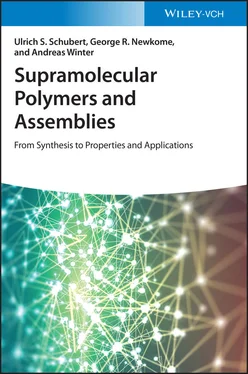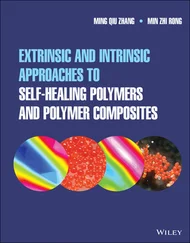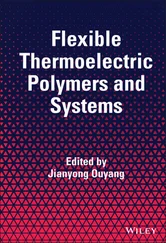K) is independent of the length of the assembly (the mechanism is shown for a bifunctional monomer of the Ia‐type, see also Figure 1.2). Source: Winter et al. [39]. © 2012 Elsevier B.V. Figure 1.6 (a) Schematic drawing of an energy diagram for an IDP (
i : size of the oligomer, Δ
G 0: free energy in arbitrary units). (b) Evolution of the number‐ and weight‐averaged DP ( Nand W) and the dispersity (
Đ ) as a function of equilibrium constant and total concentration of monomer (
K ·
c t). Source: de Greef et al. [26]. © 2009 American Chemical Society. Figure 1.7 Illustration of the characteristic properties of a temperature‐dependent IDP according to van der Schoot's model: (a) fraction of polymerized material (
φ ) vs. the dimensionless temperature
T /
T m; (b) Nvs.
T /
T m. In both plots, the curves obtained for different enthalpies are shown (Δ
H p= −30, −40, and −50 kJ mol −1, respectively). Source: van der Schoot et al. [57]. © 2005 Taylor & Francis. Figure 1.8 Illustration of the characteristic properties of a temperature‐dependent IDP according to the “free association” model: (a) fraction of polymerized monomers (
φ ) vs.
T /
T m(assuming fully flexible polymer chains and a cubic lattice); (b) heat capacity at constant volume (
C V) vs.
T /
T m. In both plots, the curves obtained for various enthalpy (Δ
H p= −30, −40, and −50 kJ mol −1, respectively) and entropy values (Δ
S p= −100, −133, and −166 J mol −1K −1, respectively) are shown; in all cases, the initial volume fraction of the monomers has been set to 0.1. Source: Modified from Dudowicz et al. [50]; Douglas et al. [51]. Figure 1.9 Schematic representation of the generalized mechanism of a ring‐chain‐mediated supramolecular polymerization. The intermolecular binding constants (
K inter) are related to the intermolecular association of molecules, whereas the intramolecular binding constant
K intra(n‐mer)is assigned to the ring closure of monomers, oligomers, and polymers. Source: Winter et al. [39]. © 2012 Elsevier B.V. Figure 1.10 (a) Schematic representation of Kuhn's concept of effective concentration (
c eff) for a heteroditopic oligomer (i.e. having two different end groups, A and B) [74]. In solution, the end group A will experience an effective concentration of B, if the latter one cannot escape from the sphere of radius
l , which is identical to the length of the stretched chain. Thus, the intramolecular association between the termini becomes favored for
c effvalues higher than the actual concentration of B end groups. (b) Illustration of how the equilibrium concentration of chains and macrocycles can be correlated to the total concentration (
c t) of a ditopic monomer in dilute solution; such a ring‐chain supramolecular polymerization typically features a critical concentration. Source: de Greef et al. [26]. © 2009 American Chemical Society. Figure 1.11 (a) Illustration of the fraction of polymerized monomer as a function of
K inter·
c tfor three different EM 1values and a fixed value of
K inter(10 6M −1). (b) Illustration of the evolution of Nas a function of
K inter·
c tfor various EM 1values. Source: Flory and Suter [91]. Figure 1.12 Schematic representation of the formation of a poly(pseudorotaxane) via a ring‐chain equilibrium. Source: Cantrill et al. [95]. © 2001 American Chemical Society. Figure 1.13 Schematic representation of a typical cooperative supramolecular polymerization reaction (nucleation‐elongation mechanism).
K nand
K erepresent the association constants for the nucleation and the elongation phase, respectively (
K n<
K e). Source: Winter et al. [39]. © 2012 Elsevier B.V. Figure 1.14 Schematic illustration of the energy diagrams of a cooperative nucleated (a) and a cooperative downhill supramolecular polymerization (b). In both plots, the axis of abscissae represents the oligomer's size (
i ), whereas the ordinate measures the Δ
G 0in arbitrary units. In diagram (a), the size of the nucleus is 2 (i.e. dimeric nucleus); in diagram (b), a tetrameric nucleus is depicted. Source: de Greef et al. [26]. © 2009 American Chemical Society. Figure 1.15 Illustration of the various thermodynamic states in supramolecular polymerizations on Gibbs free energy landscape. Source: Sorrenti et al. [40]. Licenced under CC BY 3.0.
2 Chapter 2 Figure 2.1 Schematic representation of the basic guanidinium–carboxylate interaction as well as of several guanidinium receptor. Source: Dietrich et al. [11]; Linton and Hamilton [12]. Figure 2.2 Schematic representation of the binding of N ‐acetyl‐protected α‐amino carboxylates to the receptor 6. Source: Schmuck [14]. Figure 2.3 (a) Schematic representation of the dimerization of the self‐complementary guanidinium derivative 7[16]. (b) Schematic representation of the supramolecular self‐assembly of the heteroditopic derivatives 8. Source: Schmuck et al. [17]. Figure reproduced with kind permission. © 1999 Wiley‐VCH and 2000 American Chemical Society, respectively. Figure 2.4 (a) Schematic representation of the self‐assembly of two complementary components in a Vernier‐type fashion (the most straightforward case, i.e. combining a ditopic and a tritopic building block is depicted). (b) Schematic representation of the self‐assembly of 9and 10into a molecular [2×3]‐Vernier motif. Source: Kelly et al. [21]. Figure 2.5 Schematic representation of the template‐driven self‐assembly of 11and 12into a supramolecular rectangle. Source: Terfort and von Kiedrowski [22]. Figure 2.6 Schematic representation of star‐shaped assembly 13and the corresponding X‐ray single crystal structure (R = CF 3). Source: Kraft and Fröhlich [23]. © 1998 Royal Chemical Society. Figure 2.7 Schematic representation of the regioselective intramolecular photolysis reaction in the ion‐paired derivative 14. Source: Breslow et al. [24]. Figure 2.8 (a) Schematic representation of the bowl‐shaped triple‐ions 15–18; (b) schematic representation (left) and space‐filling model of the ion pair 16 × 18(right). Source: Grawe et al. [27]. Figure reproduced with kind permission. © 2002 American Chemical Society. Figure 2.9 (a) Schematic representation of metalloporphyrin 19and calix[4]arene 20, as building blocks for supramolecular capsule formation. (b) Illustration of the simulated structure of the capsule (CHARMn 24.0). Source: Rehm and Schmuck [7]. © 2010 Royal society of chemistry. Figure 2.10 Schematic representation of cavitand 21and its anion‐supported self‐assembly into a ( 21 2X 4) capsule (X denotes as monovalent anion). Source: Oshovsky et al. [31]. © 2006 American Chemical Society. Figure 2.11 Proposed phase diagram for the supramolecular polymer formed by HOOC–PαMS–COOH ( M W= 10 kDa) and H 2N–PI–NH 2PIP ( M W= 18 kDa). The constituent blocks phase separated at the UCST. ODT denotes the regime for the order–disorder transition of the block copolymer structure. T gand T idefine the glass transition and dissociation temperature, respectively. Microphase separation can be observed in the left‐to‐right diagonally hatched area; the mixture of telechelic polymers is macroscopically phase separated in the right‐to‐left diagonally hatched area. In the stippled regime, the copolymer is disordered phase, and finally, the clear area represents a homogeneous mixture of the two constituent polymers. The dashed lines represent the proposed continuations of the curves, which were experimentally not accessible due to ionic aggregation and/or cleavage of the supramolecular bonds. Source: Russell et al. [47]. © 1988 American Chemical Society. Figure 2.12 (a) Scheme representation of the vesicles formed by the self‐assembly of PS‐COOH and PNIPAM‐NH 2in aq. dioxane. (b) Representative TEM image of the thusly obtained vesicles. Source: Qian and Wu [64]. Figure reproduced with kind permission. © 2008 American Chemical Society. Figure 2.13 Transmission electron microscopy (TEM) images of ionically end‐capped PS‐ b ‐PI: (a) Me 3N +‐PS‐ b ‐PI; (b) Me 3N +‐ PS ‐ b ‐ PI ‐ SO 3 −. Source: Schädler et al. [67]. Figure reproduced with kind permission. © American Chemical Society. Figure 2.14 Pictures of an “intelligent” supramolecular rubber, which exhibited (a) self‐healing and (b) shape‐memory properties. Source: Wang et al. [68]. Figure reproduced with kind permission. © 2015 The Royal Chemical Society. Figure 2.15 Schematic representation of the self‐assembly of a multi‐arm, star‐shaped polymers containing a POM, as polyanionic core (counterions omitted for clarity). Representative (a) TEM, (b) AFM, and (c) Scanning electron microscopy (SEM) images of the vesicles formed by the star‐shaped polymers are also shown ( n = 169). Source: Zhang et al. [69]. Figure reproduced with kind permission. © 2012 The Royal Chemical Society. Figure 2.16 Schematic representation of POM‐centered supramolecular polymers via a surface‐started RAFT polymerization. As shown by representative TEM images, the morphology of the self‐assembled nanostructure depended on the length of the PS chains. Source: Cao et al. [72]. Figure reproduced with kind permission. © 2016 The Royal Chemical Society. Figure 2.17 Schematic representation of the morphologies of pristine PS 488‐ b ‐P4VP 95(a) and the nanocomposite with added H 4SiW 12O 40(b). Source: Zhang et al. [76]. Figure reproduced with kind permission. © 2016 Elsevier B.V. Figure 2.18 Schematic representation of the self‐assembly of the heteroditopic monomer 22in a head‐to‐tail fashion. The concentration‐dependency of the self‐assembly process, as studied by 1H NMR spectroscopy, is also shown. Source: Schmuck [20]. © 2001 Elsevier B.V. Figure 2.19 Schematic representation of the different self‐assembly modes of zwitterion 23dictated by the length of the alkyl chain. Source: Schmuck et al. [79]. © 2007 American Chemical Society. Figure 2.20 (a) Schematic representation of zwitterions 24functionalized with amino‐acid residues. (b) Representative TEM image of a vesicle formed by the self‐assembly of 24ain DMSO (after staining with uranyl acetate). (c) Calculated structure of a membrane segment (the Me‐groups of the alanine moieties, essential for the vesicle formation are depicted in yellow); a view along the rows of stacked dimers showing the vesicle curvature as well as side view of the stacked dimers showing their alternating antiparallel orientation. Source: Rehm et al. [80]. Figure reproduced with kind permission. © 2008 American Chemical Society. Figure 2.21 Schematic representation of the tris‐zwitterion 25. The AFM images of the assemblies after spin‐coating onto mica substrates are also depicted: large plates were obtained on the surface at high rotational speed (7000 rpm, a and b); the plates merged at lower rotational speed (5000 rpm, c) and, finally, fully disintegrate into the 2D network of ribbons (d). A cross‐sectional plot of three representative plates is also shown (e, also depicted as yellow line in b) exhibited uniform heights and diameters of c. 450 and 2.5 nm, respectively. Source: Rehm et al. [82]. Figure reproduced with kind permission. © 2012 The Royal Chemical Society. Figure 2.22 Polarizing microscopy image of the PAA–dodecyltrimethylammonium complex (extension of λ = 1.5 nm). Source: Antonietti and Conrad [87]. Figure reproduced with kind permission. © 1994 Wiley‐VCH. Figure 2.23 Schematic representation of the supramolecular grafting of sulfonates onto P4VP. Source: Ikkala et al. [93]. Figure 2.24 Schematic representation of the formation of helical strands from the achiral polyacetylene derivative 25induced by ion pairing with chiral amines. Source: Yashima et al. [101]. © 1999 Springer Nature. Figure 2.25 (a) Schematic representation of polymers R ‐ 28and 29that self‐assemble into right‐handed double helices in polar‐aprotic solvents. (b) Wide‐angle XRD pattern and AFM phase image (40 nm × 40 nm) of R ‐ 28 × 29along with a molecular model of the double‐stranded helical structure. Source: Maeda et al. [103]. Figure reproduced with kind permission. © 2008 American Chemical Society.Figure 2.26 Schematic representation of the two different structural modes for stoichiometric PECs. (a) Ladder‐type structure and (b) “Scrambled egg” structure.
Читать дальше












